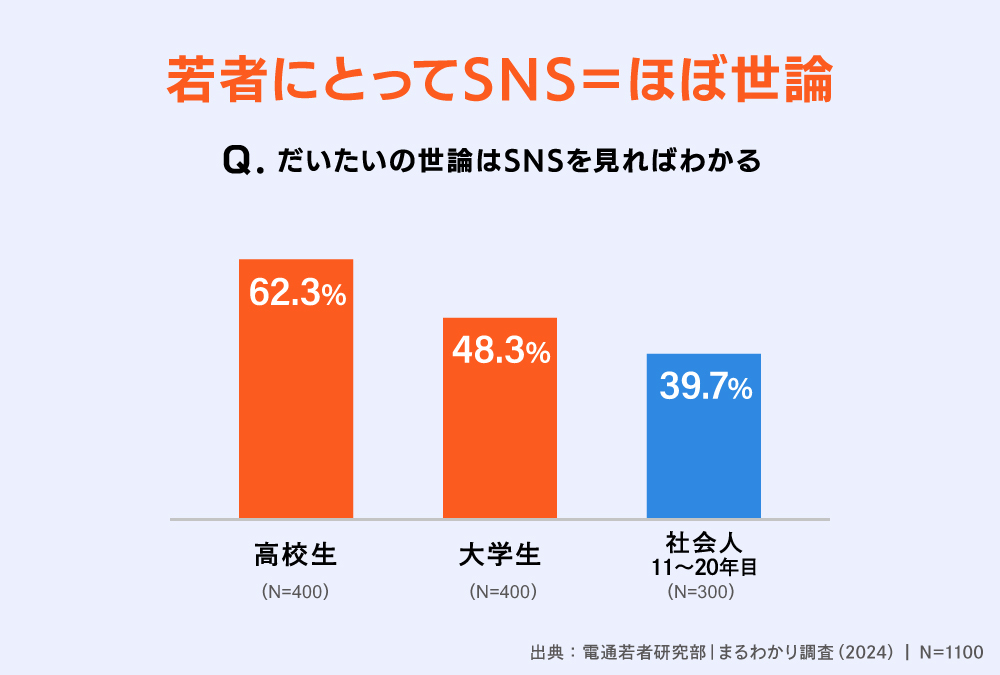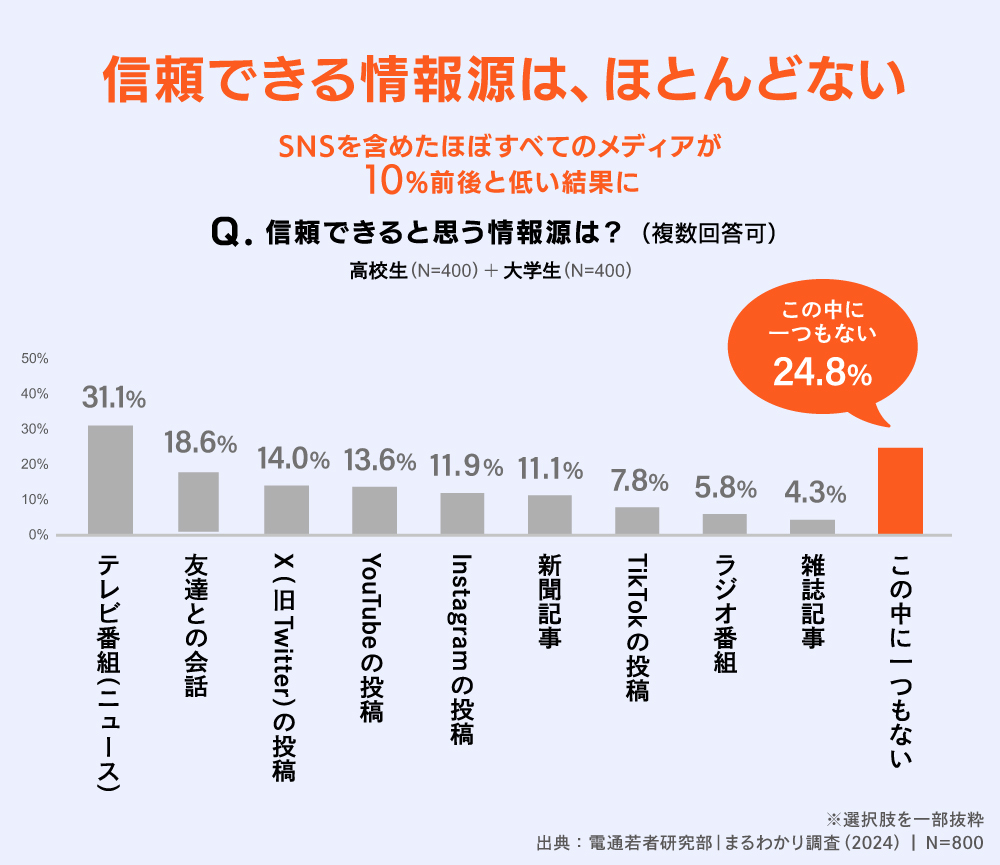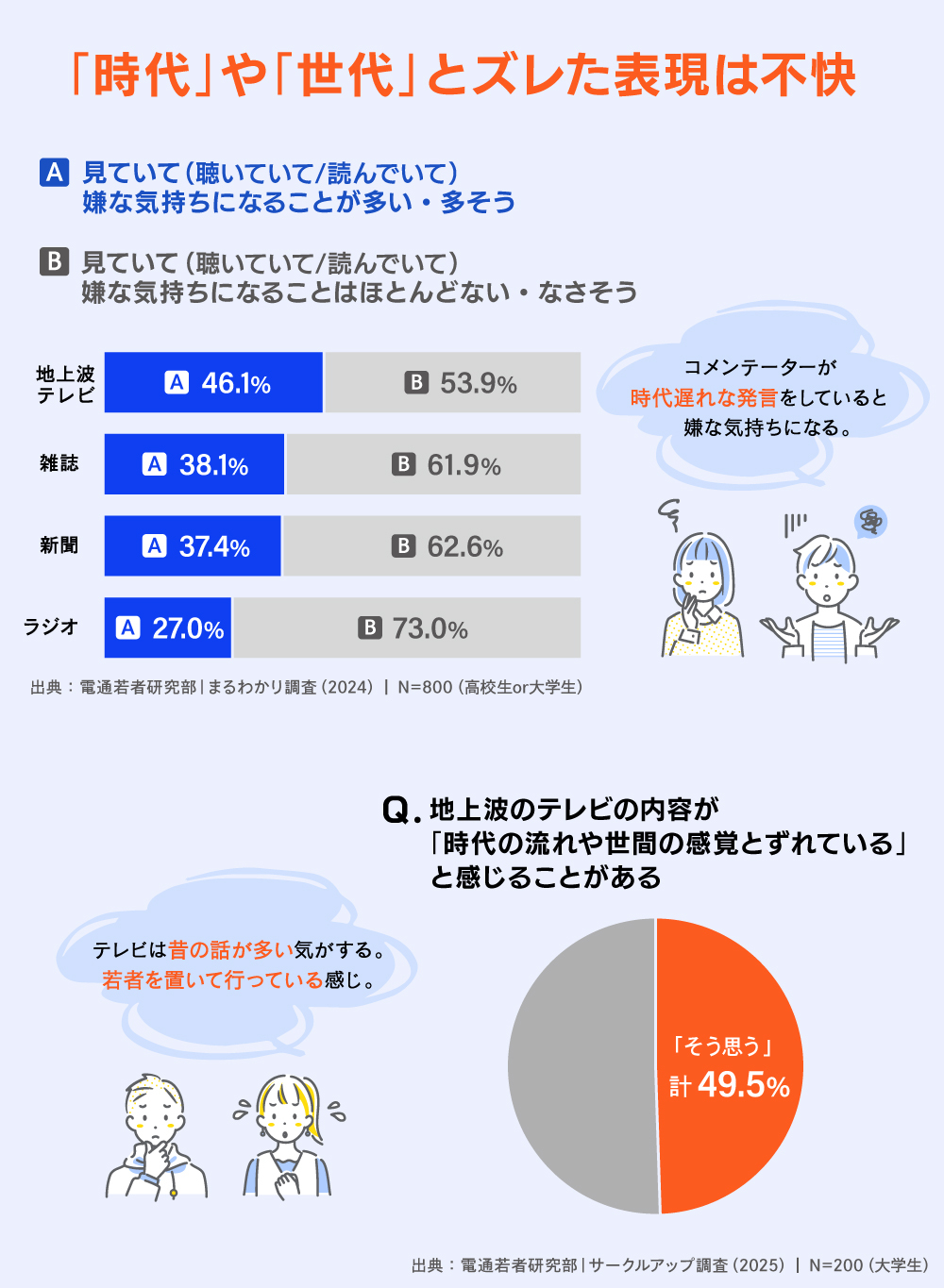Dentsu Inc. Youth Research Department (hereafter Dentsu Inc. Wakamon) conducted its first large-scale survey in two years, focusing primarily on high school students, university students, and young professionals in their first to third years of employment ( survey overview here ). Based on these findings, we created "Youth Comprehension Knowledge 2025 (Media Edition)" to explore young people's relationship with media. ( Contact us here )
This article introduces key findings from the survey and examines young people's relationship with media.
SNS is "Almost Public Opinion"
The proliferation of the internet has drastically transformed the media landscape. Contact rates with the "four major media" (newspapers, magazines, radio, and television) now lag behind the internet, ushering in an era demanding a redefinition of the term "mass media" itself.
For young people especially, freely available time is surprisingly limited. They are swamped with part-time jobs, internships, club activities, assignments, and time with friends. For many, the very idea of "making time to watch TV" is no longer an option.
Young people efficiently filter information to their needs by utilizing techniques like double-speed viewing, clip videos, and AI-generated summaries and recommendations. This "self-centered" approach to selecting information has already become second nature.
Furthermore, young people increasingly perceive social media as "public opinion itself." Over 60% of high school students responded that "you can understand general public opinion by looking at social media." For a generation that grew up seeing news stories go viral on social media and then being picked up by TV, the equation "trending on social media = trending in society" feels perfectly natural.

For sources, please refer to "Survey Overview 1" at the end of the article.
When gathering information, they primarily reference reactions on social media and conversations with friends, with their criteria for selecting information boiling down to "whether they can relate it to themselves."

For sources, please refer to "Survey Overview 1" at the end of the article.
There are no reliable sources of information
On the other hand, the current reality that young people have almost no reliable sources of information cannot be overlooked. Even social media, cited as a "reference," received a low rating as a "reliable source" at around 10%. Furthermore, approximately one in four respondents stated they had "no reliable sources at all." This indicates that young people do not unconditionally trust specific sources. Instead, they hone their information literacy, compare multiple sources, and pursue their own "convincing answers."

For sources, please refer to "Survey Overview 1" at the end of the article.
Furthermore, distrust in mass media is growing stronger each year. Young people, in particular, are sensitive to risks and expressions, reacting strongly to excessive dramatization or unpleasant content on television and similar platforms. In fact, interviews with university students revealed comments like, "It makes me uncomfortable when TV commentators make outdated remarks," and "It feels like they're broadcasting without understanding young people, leaving us behind." This suggests that the moment viewers feel the information isn't directed at them, their willingness to watch and their sense of empathy vanish.

For sources, please refer to "Survey Overview 1" and "Survey Overview 2" at the end of the article.
Furthermore, ongoing coverage of scandals and biased reporting has shaken trust in the media as a whole. What young people value now is not so much "what is being communicated" but rather the media's stance on "how they engage with that information." It's not just the content being disseminated, but the underlying stance and sincere approach behind it that have become decisive factors in determining trust and empathy.
Ultimately, what matters most is the content's appeal, not the medium itself.
Amidst a landscape lacking trustworthy media, there is a growing tendency to prioritize "whether the content itself is interesting," regardless of the media type. In other words, it is the appeal of the content itself, not the power of the medium, that is becoming the deciding factor for viewing or subscribing.

For sources, please refer to "Research Overview 1" at the end of the article.
On the other hand, young people have a very strong desire to avoid wasting time. Therefore, the situation where "I watched it but it wasn't interesting" is the worst possible outcome in terms of time performance (TPA). Consequently, it has become commonplace to seek a "guarantee of interest" beforehand by using social media clips or summary videos before watching the full content.
Indeed, 61.8% of young people responded that they "don't watch TV programs on TV, but often watch them via social media clips." Designing short, engaging entry points will become an indispensable element in future content development.

For sources, please refer to "Survey Overview 1" at the end of the article.
It's now commonplace for content that went viral on SNS to be featured on TV, or for TV-originated content to spread on SNS. We should move beyond thinking in terms of "which is primary or secondary" and instead view TV and SNS as mutually reinforcing, complementary partners.
What is the future value of television?
In an era where people are increasingly turning away from television and trust in media is declining, what role and value should television embrace moving forward? Dentsu Inc. believes two values of television will become increasingly important:
① Becoming a "Common Language" with Older Generations
It has become clear that many young people today actually feel "television has significant influence on society." Interestingly, they hold this impression regardless of whether they personally watch television.
Why do young people feel television has influence even if they don't watch it? When asked why, the most common response was "because older generations watch it." Many comments included statements like: "I don't watch it myself, but generations like my parents or bosses watch television frequently," and "As the population ages, more people are exposed to television than the internet."
In other words, young people calmly grasp the fact that many people still watch TV, even if they themselves don't, and through this, they objectively recognize television's social influence.
Furthermore, when asked, "Do you think television plays a role in bridging the gap in values between parents/superiors and younger generations?", a remarkable 70% or more responded with "I think so" or "I somewhat think so." This suggests television has the potential to serve a new role as a "common language" shared across generations.

For sources, please refer to "Survey Overview 3" at the end of the article.
② From Momentum Building to "Momentum Consolidation"
Television has historically played a major role as a medium for "creating momentum" (momentum building). Leveraging its powerful reach to deliver information simultaneously to the entire nation, it has functioned as a platform for "momentum building," spreading social moods and values.
However, with the spread of the internet and the decline in television viewership, the perception that "SNS = public opinion" has become widespread among young people. As a result, the media that fosters social momentum has become extremely diverse, encompassing not only television but also SNS and individual content.
In this environment, what role should television play going forward? We at Dentsu Inc. Wakamon believe it is to "solidify momentum."
Indeed, approximately 90% of university students feel that "values or ideas they didn't know about can become 'common sense' through repeated coverage on TV." Furthermore, over 60% responded that "even values born on SNS can fade away without taking root if they aren't covered on TV." For instance, numerous voices expressed that topics like "LGBTQ," "men's makeup," and "men using parasols" changed their personal sense of what was normal after being featured on television.
In other words, television consolidates movements that emerge sporadically on social media and "establishes" them throughout society. We believe this role represents the new value television should embrace moving forward.

For sources, please refer to "Survey Overview 3" at the end of the article.
The above are the findings obtained from the survey. We hope you find them useful for selecting media when communicating information to young people and for content planning.
[Survey Overview 1]
Survey Name: Young People Survey
Research Organization: Dentsu Macromill Insight, Inc.
Survey Period: December 2024
Survey Method: Internet survey
Survey Area: Nationwide
Survey Population/Sample: Unmarried males and females aged 15-46 (high school students and above) - 2000 ss (equally divided by gender for each segment below)
(Breakdown) High school students: 400 ss / College students: 400 ss / Working adults (1-3 years): 400 ss / Working adults (4-10 years): 500 ss / Working adults (11-20 years): 300 ss
*For the above sample extraction, a screening survey was conducted targeting general men and women aged 15–69 (high school students and above, regardless of marital status or occupation). Based on the results, 10,000 respondents were extracted according to population composition ratios and used separately for analysis.
[Survey Overview 2]
Survey Name: Circle Up Survey
Research Organization: Dentsu Inc. Youth Research Department (Wakamon)
Survey Period: May 2025
Survey Method: Internet survey
Survey Area: Nationwide
Survey Subjects/Sample: College Students, 200 respondents
[Survey Overview 3]
Survey Name: Circle Up Survey
Research Organization: Dentsu Inc. Youth Research Department (Wakamon)
Survey Period: July 2025
Survey Method: Internet survey
Survey Area: Nationwide
Survey Participants/Sample: University Students, 500 respondents













